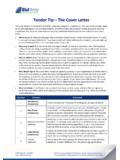Transcription of Metabolic Testing cover for sample report v2
1 !! Metabolic Testing Metabolism Testing involves monitoring a person's breathing (oxygen consumption and carbon dioxide production) using a machine called ECAL. ECAL is a portable indirect calorimeter, which is used to measure human metabolism. An Indirect Calorimeter is considered the gold standard for measuring Metabolic rate. Information gathered from ECAL includes your 1) daily energy requirement at rest in calories 2) which source this energy is being produced from (fat or carbohydrate) and 3) the efficiency with which you use oxygen. ECAL involves a 5-10 minute breath analysis, in a semi reclined position. After entering some personal details we will ask you to put a mouthpiece in and nose plug on. During the test we would like you to relax and breathe as normally as possible through the mouthpiece.
2 Price Resting Metabolic Rate (RMR) + Energy Test 1. $ report only 2. $ Detailed explanation of results !!Page%1%of%2% RESTING Metabolic PROFILE Test Score Normal Range Optimal Resting Metabolism (kcal) 1175 1190 - 1454 N/A Resting Metabolism (kJ) 4919 4982 - 6088 N/A Fat Burning (%) 48 - 83 80 Glucose Availability (%) 17 - 52 20 Efficiency (FEO2) (%) 16 - 17 < 15 Background Energy production (metabolism) is vital to sustain every aspect of life and consequently is a key component of your health. For example, compromised energy production often results in an energy-related condition such as Obesity, Diabetes, Metabolic Syndrome, Chronic Fatigue, Insulin Resistance or a Sleep Disorder and may also be related to problems such hyperactivity, insomnia and an increased rate of aging.
3 Therefore understanding and optimising your metabolism is key to improving your health, weight management and wellbeing. As humans we obtain energy from the food and liquids (fuel) consumed. The digestion of these nutrients and the subsequent absorption makes it possible for the mitochondria in cells to transform the potential chemical energy of food into the energy we use for life. This energy is normally produced from a mixture of glucose (from carbohydrates) and fat. At rest and light exercise the body should produce around 80% of the required energy from fat stores. Under high intensity exercise the body gradually switches from burning fats to glucose. The ratio of these two fuels is highly individual and is determined primarily by the amount of glucose available, but also hormone function, fitness, muscle mass and general health.
4 We have used a gold standard research technology called Indirect Calorimetry to measure your energy production. The device called ECAL allows our practitioners to accurately measure your daily energy requirement at rest, which nutrient source the energy is being produced from (fat and/or carbohydrate) and the efficiency with which your cells use oxygen. Conventionally these energy requirements would be assessed using population based equations. However these are widely accepted as inaccurate because they cannot take into account individual variations in body composition, hormone function and physical activity levels. This can often lead to frustration for both client and practitioner. All of your test results are displayed in a table above, and where relevant normal or optimal values are also shown.
5 However your Metabolic profile is completely unique and therefore comparisons with these values are for general information only. Energy Testing should be repeated over time and particularly following dietary or exercise intervention. This way you can measure the effectiveness of any strategy designed to improve your weight, energy and general health. !Page%2%of%2%An explanation of each test score is provided and may include specific recommendations to optimize your energy production if necessary. Please consult with your health practitioner for appropriate diet, exercise or clinical intervention advice 1175 Resting Metabolism (REP/RMR) - This is the number of calories that would be expended over a 24 hour period if a person remained at rest/light activity.
6 It usually represents around 65 - 80% of a person's total energy needs and is influenced by various factors including body composition, surface area, efficiency, age and hormones. ECAL accurately measures RMR and compares this against estimated values based on age, height, weight and sex. Fat Burning (%) - This score indicates the percentage of energy being generated from fat stores. The human body is designed to generate around 80% of total energy from fat stores at rest. This is particularly important for weight loss - to lose weight fat must be burnt. Factors that affect fat utilisation include diet, hormone function and physiological stress. Glucose Availability (%) - This score indicates the amount of glucose (carbohydrate) currently available to generate energy.
7 A surplus of glucose can result in elevated blood sugar levels, the storage of glucose and the conversion of glucose excess to fat, through a process known as lipogenesis. Efficiency (FEO2) - Our mitochondria (the part of the cell responsible for energy production) requires oxygen to convert the food we consume into useable energy. Healthier cells are more efficient and can therefore utilise more oxygen from the atmosphere - a lower value indicates more efficient mitochondria.




